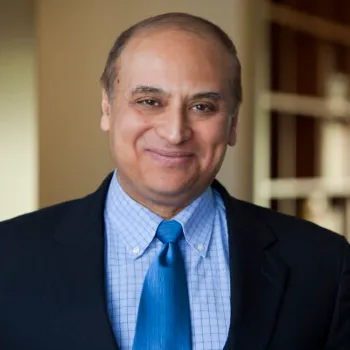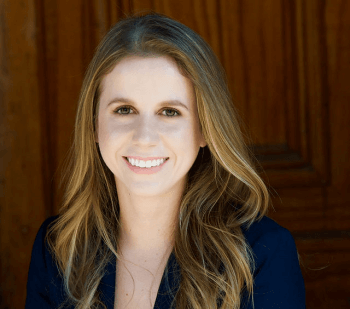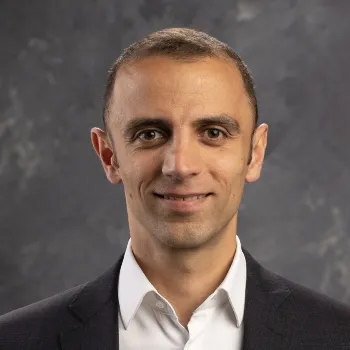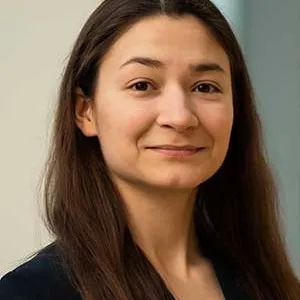21st Annual Olin Finance Conference at WashU
October 16-17, 2025
WashU Olin Business School and its Wells Fargo Advisors Center for Finance and Accounting Research (WFA CFAR) cordially invite you to attend the 21st Annual Olin Finance Conference at WashU, October 16-17, 2025.
We look forward to seeing you at the conference!
CONFERENCE COMMITTEE
Anjan Thakor (co-chair)
Linda Schilling (co-chair)
Sponsor/Organizers
Conference sponsored by theWells Fargo Advisors Center for
Finance and Accounting Research at
WashU Olin Business School
Organizers:



Presenters












Discussants












Session Chairs






Papers
A Trilemma for Asset Demand Estimation
William Fuchs, Satoshi Fukuda, Daniel Neuhann
Canonical portfolio choice models require no arbitrage to ensure the existence of smooth, low-dimensional asset demand functions that are amenable to demand estimation. But because no arbitrage imposes cross-asset restrictions on prices, supply shocks generically fail to generate the ceteris paribus price variation required to identify asset-level demand elasticities. This yields a trilemma for demand estimation in financial markets: given observational data, one cannot jointly require (i) no arbitrage, (ii) preferences over state-contingent payoffs, and (iii) ceteris paribus variation from asset supply shocks. Because the ideal experiment is unobservable, model-based inference is necessarily sensitive to the assumed structure.
Does Fund Size Affect Private Equity Performance? Evidence from Donations to Private Universities
Abhishek Bhardwaj, Abhinav Gupta, Sabrina T. Howell, Kyle E. Zimmerschied
Do private equity (PE) returns rise or fall with fund scale? A causal effect is difficult to identify because better managers can raise larger funds. We develop an instrument using donations to universities. Donations affect fund size because endowments are sensitive to donation income, have sticky relationships with PE managers, and signal fund quality to other Limited Partner investors. We show decreasing returns to scale: a 1% size increase in fund size reduces net IRR by 0.1 percentage points. Larger funds do larger deals, which underperform. We find no change in risk, in part because additional deals are more levered.
Financial Flexibility under Financing Constraints and Non-Exclusive Lending
Yunzhi Hu, Felipe Varas
This paper examines optimal financial flexibility for firms under financing constraints and nonexclusive lending. We develop a model in which a borrower requires funding for an initial investment and seeks additional financing later following a privately observed liquidity shock. Non-exclusivity creates incentives to dilute initial debt, leading to excessive total borrowing. The optimal contract is an endogenous debt limit: firms with mild shocks retain flexibility but over-borrow (relative to second-best), while those with severe shocks face binding constraintsand under-borrow. This limit optimally trades off debt dilution against liquidity needs.
Firms as Electoral Monopsonies
Carlos F. Avenancio-Leon, Adelina Barbalau, Cyndi Xinyu Hou, Alessio Piccolo
We study how dominant employers can act as electoral monopsonies, directly shaping electoral outcomes by leveraging local labor market power. We consider a model where a dominant employer can reshape the political preferences of the local electorate by conditioning their degree of economic activity on electoral outcomes. This form of electoral interference creates polarization in the community: some voters turn against redistributive policy, in some cases strongly, as they may benefit from the firm’s economic activity. Over time, however, the firm’s influence undermines local institutions and labor markets, ultimately harming all voters and, in some cases, the firm itself. Using U.S. individual voting records data and a shift-share instrument based on national industry trends and historical local employment patterns, we test the model’s predictions and show that areas with higher employment concentration are more likely to see increased voter registration, turnout, and campaign donations for the Republican party. These political shifts are accompanied by long-run declines in population, labor force, tax base, and per capita public sector size.
Tristan Fitzgerald, Korok Ray
Using a proprietary dataset detailing all startup applications, all internal judging scores and judges’ written comments, all signed financing contracts, and even all audio recordings of interviews and contract negotiations involving one of the largest venture capital-backed startup accelerators in the United States, we open the ‘black box’ of venture capital (VC) decision-making. We first study the entire internal VC investment selection process by examining the key determinants of judging scores from initial screening through to final portfolio firm decisions. For example, by focusing on how individual VC partners/employees evaluate the same potential portfolio firm, we provide novel evidence on the existence of significant VC judge-founder ‘homophily’ biases and detail how different judging settings (e.g., solo vs. group evaluations; availability of quantitative vs. qualitative information) can amplify or mitigate such biases. Second, we document the value implications of adopting different judging policies and scoring aggregation rules (e.g., consensus vs. champion-based decision rules) for VC fund performance. Finally, we are the first to empirically document the key features of a recent innovation in startup firm financial contracting instruments (namely Simple Agreement for Future Equity (SAFE) and Keep It Simple Security (KISS) contracts) and investigate their relationship with startup firm characteristics and internal VC evaluations. We offer novel insights into the role of a salient ‘anchor’ or ‘reference point’ in setting future equity pricing terms as well as the importance of startup financial constraints in VC term sheet negotiations.
HOUSING DURATION AND INTEREST RATES: EVIDENCE FROM REACHING-FOR-INCOME INVESTORS
Gen Li
Fixed-income theory posits that longer-duration bonds are more sensitive to interest rate changes, and many assume this principle extends to other assets. Contrary to this view, I document a striking inversion in housing markets: shorter-duration properties exhibit greater sensitivity to monetary policy changes. I construct a novel zip-code–level measure of housing duration based on Macaulay duration, showing that shorter duration corresponds to higher rental yields. On average, a 100 basis-point cut in the federal funds rate raises house prices by 1.86 percent over two years, but markets with durations one standard deviation shorter experience an additional 0.71-percentage-point increase—about 38 percent of the average response. Using 30 million property transaction records combined with rental listings, I confirm the inverse duration–sensitivity relationship at the property level. The property-level evidence shows that the inversion is driven by the discount-rate channel through “reaching-for-income” investors. After rate cuts, income-seeking investors disproportionately target high-yield properties for rental purposes and prioritize near-term income over long-run returns. Their demand raises local prices and lowers discount rates more in short- than long-duration markets, generating a non-parallel shift in the housing term structure. Overall, the paper highlights an investor-driven channel in which rental-income preferences shape monetary policy transmission heterogeneity across housing markets.
Price Regulation and Cream-Skimming: How Private Equity Competes with Government-Backed Firms
Cameron Ellis, Meghan Esson
We examine how private equity (PE) firms generate value in markets where prices are regulated and do not reflect costs. Using novel data from Arizona's ambulance industry, we find PE-owned companies increase operating profits by 50\% through cream-skimming: strategically exploiting regulations, and avoiding minimum service requirements, to shift unprofitable customers to the government while retaining high-profit customers. In the ambulance industry, they accomplish this by firing paramedics, which, due to nationwide staffing regulations, forces local fire departments to take high-cost runs. This strategic reallocation only occurs where PE firms overlap with fire departments, which allows them to avoid minimum timing requirements. This impacts public health -- leading to 200 additional traffic fatalities in Arizona and a 7\% increase nationally. Our findings demonstrate how PE profit maximization in mixed public-private markets can create substantial negative externalities for both public balance sheets and public health.
Set it and Forget it: Engineering Investment Habits with FinTech
Antonio Gargano, Alberto Rossi
We study how automated investment rules affect saving behavior and investment outcomes using detailed data from a FinTech app designed to help small investors access mutual funds. Users choose how to design these rules, which vary along dimensions such as frequency, amount, and triggering conditions. Using a randomized encouragement design, we show that automated rules causally increase average savings without crowding out manual contributions. We also show that automated rules reduce trend-chasing.
The covenant-defeasance option in corporate bonds
Carsten Bienz, Zsuzsanna Fluck, Karin S. Thorburn
Corporate bonds include restrictive covenants that can prevent firms from pursuing valuable growth opportunities ex-post and are virtually impossible to renegotiate. We study a common but little known contractual provision—the defeasance option—which allows issuers to immediately remove all covenants without retiring the bond. Our theoretical model predicts, and our large-sample empirical analysis confirms, that financially constrained issuers facing high uncertainty and valuable growth opportunities, and bonds with numerous covenants, are more likely to include defeasance. We also show that investors demand lower yields when defeasance is included in non-callable and make-whole bonds, but higher yields in fixed-price callable bonds.
The Effects of Deleting Medical Debt from Consumer Credit Reports
Victor Duarte, Julia Fonseca, Divij Kohli, Julian Reif
One in seven Americans carry medical debt, with $88 billion reported on consumer credit reports. In April 2023, the three major credit bureaus stopped reporting medical debts below $500. We study the effects of this information deletion on consumer credit scores, credit limits and utilization, repayment behavior, and payday borrowing. Contrary to expectations that removing this negative credit information would improve credit access for affected individuals, a regression discontinuity analysis comparing individuals above and below the $500 threshold finds no direct benefits from the information deletion, ruling out small changes. To help interpret these findings, we build credit scoring models using machine learning techniques and show that small medical debts are not meaningfully predictive of defaults, indicating that they contribute little to credit risk assessment. Finally, we show that larger medical debts (>= $500) are also not meaningfully predictive of default, suggesting that eliminating medical debts entirely from credit reports, as planned under a January 2025 decision by the Consumer Financial Protection Bureau, is unlikely to affect credit outcomes.
The Pricing of Geopolitical Tensions over a Century
Andrei Goncalves, Alessandro Melone, Andrea Ricciardi
We study the asset pricing implications of geopolitical tensions using nearly 100 years of data. Leveraging widely adopted news-based geopolitical risk indices, we find that geopolitical threats (GPT) and acts (GPA) have markedly different effects. GPT aligns closely with investors’ risk perceptions from ratings and surveys and predicts long-run consumption disasters. It is priced across individual US stocks, equity anomalies, and international equity and bond indices. GPT also captures time variation in country-level equity premia and firm investment. In contrast, GPA exhibits weaker and less stable links to risk perceptions, risk premia, and investment. We demonstrate that these findings are consistent with an Epstein-Zin investor facing time-varying disaster probabilities. Importantly, our results are incremental to news-based risk indices capturing war-related discourse, market volatility, economic and trade policy, and general macro-financial uncertainty. Overall, our findings underscore the importance of forward-looking measures like GPT for understanding how news-based uncertainty affects asset prices.
Tingyue Cui, Ricardo Delao, Sean Myers
Subjective expectations and asset prices both revolve around distorted probabilities. Subjective expectations are expectations under biased probabilities, and asset prices are expectations under risk-neutral probabilities. Given this link, asset pricing techniques designed to estimate a Stochastic Discount Factor (SDF) can be used to estimate a Subjective Belief Factor (SBF) – a distortion that characterizes many subjective expectations, even for non-financial variables. Further, the Subjective Belief Factor can be used to characterize asset prices, by separating the roles of beliefs and preferences/risk. Using the Survey of Professional Forecasters and Blue Chip, we find that differences between subjective expectations and statistical expectations for 24 macroeconomic variables can be summarized (average R-squared of 50%) by a single SBF related to real GDP growth and the T-bill rate. This SBF accurately replicates differences across the 24 variables in the serial correlation of forecast errors and under/overreaction. Applying this SBF to cross-sectional stock returns, we find it accounts for the majority of excess returns for the Fama-French factors and explains about two thirds of the variation in returns across 176 anomalies, while the remaining third is attributed to preferences/risk. Our results support models like diagnostic expectations and robust control in which agents' beliefs across different variables are characterized by a single probability distortion.
PhD Poster Session







Local Hotel Information
Approximately 1.7 miles from the Charles F. Knight Center/Washington University campus.
7730 Bonhomme Avenue, St. Louis, MO 63105. Phone: (314) 863-0400.
Approximately 2 miles from the Charles F. Knight Center/Washington University campus.
Individual reservations can be made online using promo code WAS for WashU corporate rate.
6300 Clayton Road, St. Louis, MO 63117. Phone: (314) 647-7300.
The Ritz-Carlton, Clayton
Approximately 1 mile from the Charles F. Knight Center/Washington University Campus.
Individual reservations can be made online using promo code WAS for WashU corporate rate.
100 Carondelet Plaza, St. Louis, MO 63105. Phone: (314) 863-6300.
Moonrise Hotel
Approximately 1 mile from the Charles F. Knight Center/Washington University Campus.
For reservations: 314-721-1111. Ask for the Washington University rate.
University City Loop 6177 Delmar Blvd, St. Louis, MO 63112. Phone: (314) 721-1111.
AC Hotel St. Louis Central West End
Approximately 2.9 miles from the Charles F. Knight Center/Washington University campus.
Individual reservations can be made online using promo code WAS for WashU corporate rate.
215 York Ave, St. Louis, MO 63108. Phone: (314) 887-4849.
